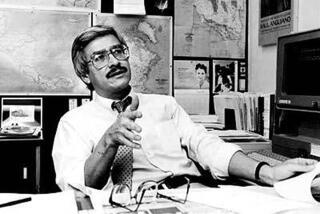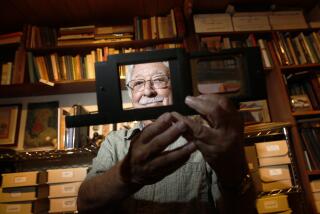Some Experts Discount Tale of Gold Ship
OCEANSIDE — The fate of Spanish explorer Francisco de Ulloa has become hazy in the centuries since he set sail northward from Mexico in 1539, and around him has grown a tale of a Spanish galleon with $11 million in Aztec gold that sank somewhere near Oceanside.
Ulloa was assigned by Hernando Cortez to explore the Gulf of California and the Pacific coast to the north of it. With three ships--the Santo Tomas, the Santa Agueda and the Trinidad--he set sail from Acapulco on July 8, 1539.
Soon afterward, the 20-ton Santo Tomas, the smallest of the three ships, sank near present-day Culiacan, Mexico. But Ulloa and his men pressed on in the Santa Agueda and the Trinidad. They sailed up the Gulf of California, briefly explored the mouth of the Colorado River, and then turned south.
After rounding what is now Cabo San Lucas, Ulloa’s party resumed its northward journey along the Pacific coast of the Baja California Peninsula, and reached Cedros Island--about 330 miles south of San Diego--on Jan. 5, 1540.
There Ulloa and his men camped for three months. But when their supplies got low, Ulloa wrote a letter to Cortez that read in part, “Determined, with the ship Trinidad, and the few supplies and men, to go on, if God grant me the weather, as far as I can.”
In April, 1540, the Santa Agueda left Cedros Island bound for Acapulco. On board were some of Ulloa’s men and his letter to Cortez. The same day, Ulloa and the rest of his crew sailed northward in the Trinidad.
As far as most historians are concerned, nothing more is known about how far Ulloa got or how long this leg of his voyage lasted. But the late Joseph Markey, an Oceanside ophthalmologist, amateur archeologist and self-avowed treasure hunter, claimed that Ulloa reached San Diego Bay on June 28, 1540. He also pointed out that this was two years before Juan Rodriguez Cabrillo came ashore in San Diego, making Ulloa the true discoverer of California, not Cabrillo.
According to Markey, Ulloa continued north after passing San Diego and went as far as Santa Barbara. Then the explorer returned to the waters off Oceanside, where he anchored the Trinidad, laden with a fortune in gold, on June 30, 1540.
Over the next two months, Ulloa and his crew went ashore at least twice, and camped near a fresh-water lake. Eventually they contracted dysentery from the lake water, and by the end of August nearly everyone in the party, including Ulloa, had died. The Trinidad broke up and sank with its treasure, and three surviving crew members rowed one of the ship’s longboats back to Acapulco.
Markey claimed to have learned about the demise of Ulloa’s expedition in an account of the voyage written by one of these three survivors, Salvador Hernandez. Hernandez’s diary supposedly was located in an archive in Spain by a Spanish professor hired by Markey, after Markey was advised of the document’s existence in a chance meeting with a descendant of Ulloa in Paris in 1950.
But historians have noted that no one but Markey ever saw Hernandez’s account of the voyage, raising serious doubts about its existence. They also point out that the Trinidad was a small ship built for coastal exploration, not a large galleon of the type that carried New World riches back to Spain. Why would Ulloa have sailed northward up the coast of North America with a fortune in gold, they ask? Most historians find Markey’s explanation that Cortez gave Ulloa the gold for trading with local Indians unconvincing.
The story of the treasure-laden Trinidad sinking near Oceanside also depends implicitly on the fact that Ulloa supposedly was never heard from again after sailing north from Cedros Island. But David Weber, a professor of history at Southern Methodist University in Dallas, has pointed out that errors in translations of Spanish documents initially led scholars to believe this.
Subsequent work has revealed that several prominent Spanish writers of the era mention Ulloa returning to Mexico in 1541, and court records show that the one-time explorer testified in a trial in Valladolid, Spain, in 1542, Weber said.
In 1951, Markey, using maps he said were included with Hernandez’s diary of the ill-fated voyage, claimed he had discovered a cave in the San Luis Rey River Valley with the skeletons of 22 Spaniards in it. Six years later, he said he had turned up a cache of 2,000 gold coins in the same valley that date from the 1st Century B.C. to A.D. 1500. Markey claimed these discoveries were proof of the accuracy of Hernandez’s account.
But Weber noted that “anyone could acquire artifacts (such as bones or coins) on the open market. The fact that a person shows up with these things isn’t very convincing evidence.” What is needed in such cases, he said, is a detailed report of the find, complete with the names of witnesses who were present when it was excavated, its location and geological strata, and other details.
Ralph Heiser, who until recently was curator of the museum at Mission San Luis Rey in Oceanside, where some of the coins discovered by Markey are stored, is even more unequivocal. Experts can easily tell that the skulls found by Markey are ape skulls, Heiser said, and the coins “could have been bought at any coin shop. They’re common Spanish coins . . . made of copper and tin, and they can’t be worth more than $10-20.”
In a skeptical article in the March, 1971, issue of the California Historical Quarterly (which was later reprinted in the San Diego Union), Weber discussed Markey’s account of Ulloa’s voyage, along with what other historians have been able to learn about the Spanish explorer. He summed up:
“At this time, we can only conclude that Francisco de Ulloa discovered California because Joseph James Markey says that he did.”
Weber called upon Markey to submit the Hernandez diary to the scrutiny of experts. Markey responded as he had for a decade: that he planned to publish a book with photographs of the diary and other documents that would clinch his argument.
But Markey died in December, 1985, without having published a book or anything else about his findings, proving--in the minds of historians--that he lacked sound evidence to back up his claims.
More to Read
Sign up for Essential California
The most important California stories and recommendations in your inbox every morning.
You may occasionally receive promotional content from the Los Angeles Times.









